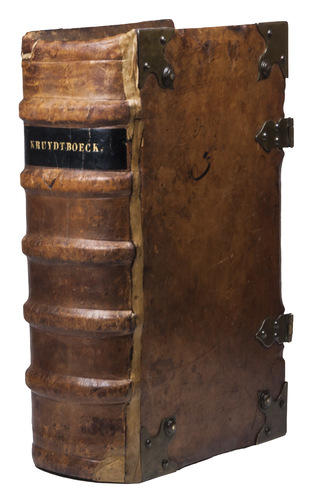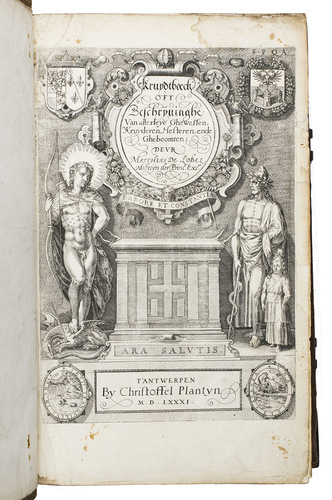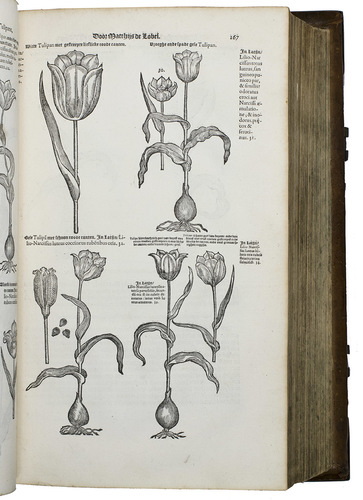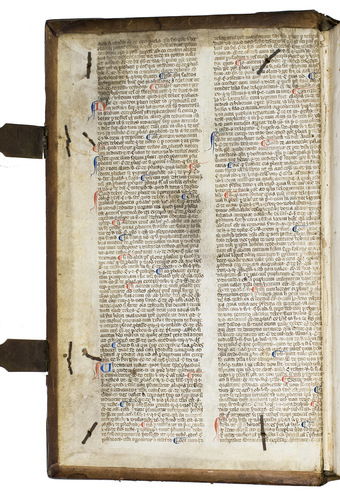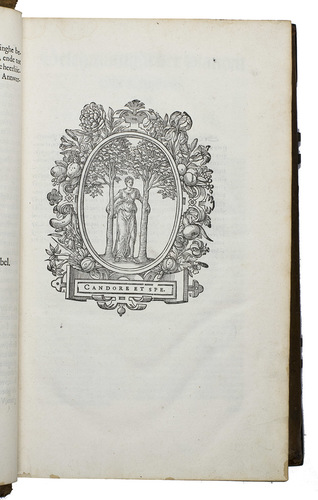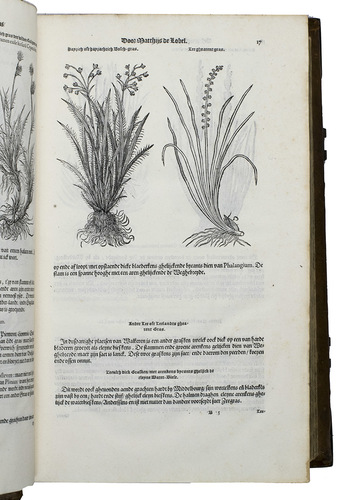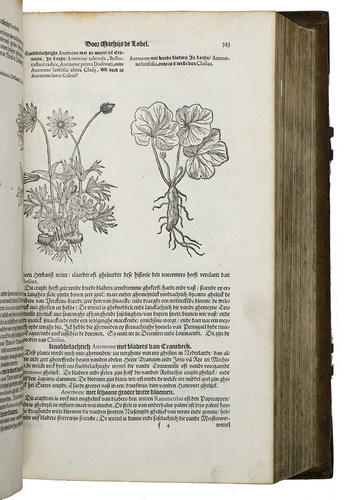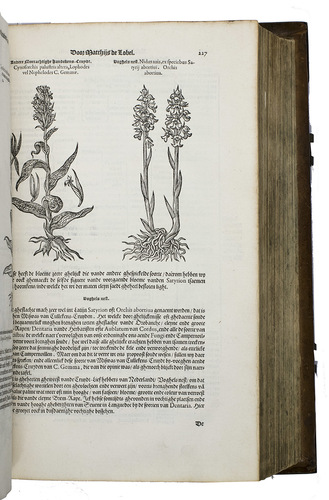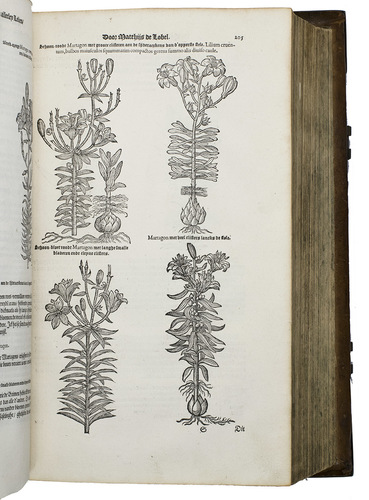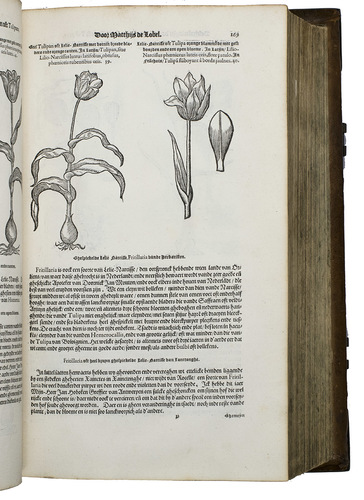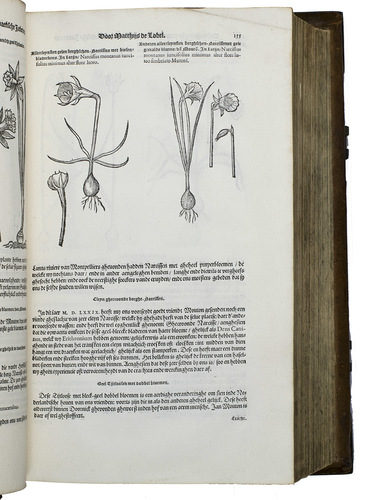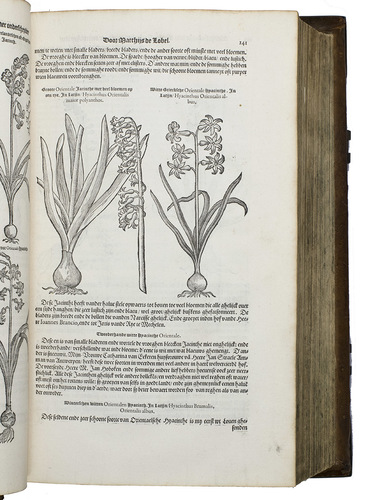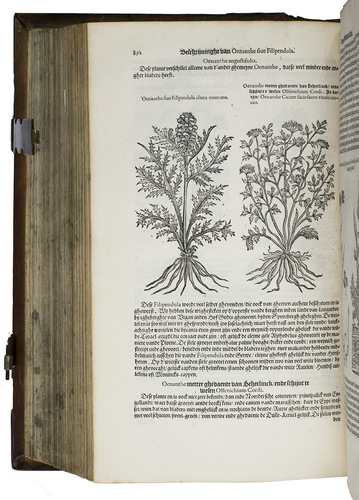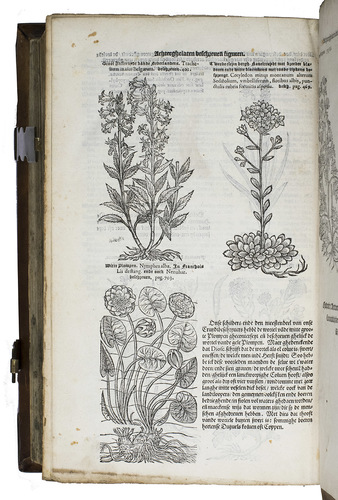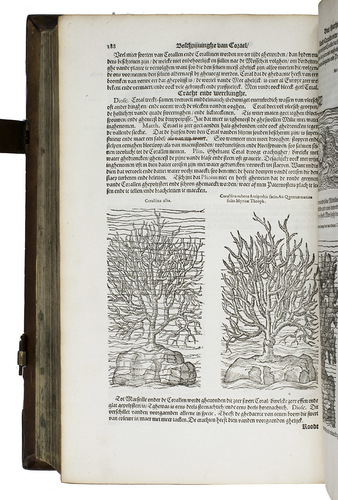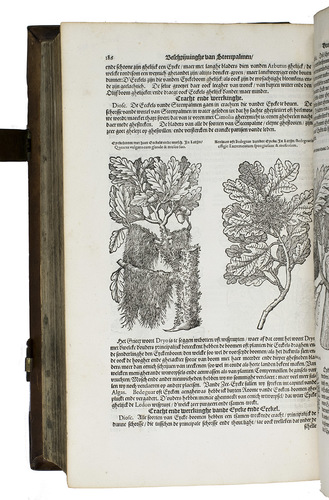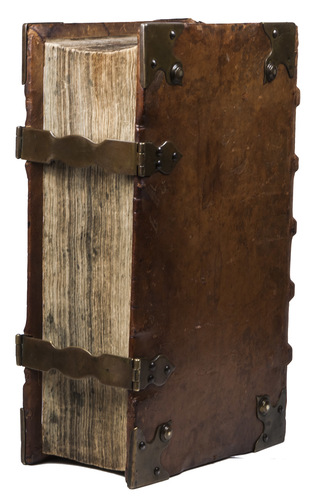LOBEL [also L'OBEL or LOBELIUS], Matthias de.
Kruydtboeck oft beschrijvinghe van allerleye ghewassen, kruyderen, hesteren, ende gheboomten.
Antwerp, Christoffel Plantin, 1581. 2 volumes bound as 1, the second in 3 parts. Large folio. With an engraved title-page, the author's large "candore et spe" woodcut device on leaf *6r, approximately 2185 botanical woodcuts in the text. The medieval manuscript parchment pastedowns are rubricated in red and ink. The Latin legal text is written in a littera bononiensis (variant of the littera textualis) in brown ink. With three loosely inserted contemporary or near contemporary slips with manuscript notes, in Dutch regarding a recipe and other notes. Tanned sheepskin over thick wooden boards (perhaps partly contemporary but refurbished in the early 19th-century) with brass fastenings. Sewn on 5 double cords supports with corresponding raised bands on the spine creating 6 compartments, with a black morocco title label lettered in gold in the second compartment, and with medieval manuscript binding waste parchment pastedowns. [10], 994, [2 blank], "312"[=314, p. 294 + 2 blank], [2 blank], 15, [1 blank], [67], [1 blank] pp.
€ 22,500
First Dutch edition, with approximately 435 more woodcuts than Plantin's Latin edition of 1576, of one of the greatest herbals. Besides the expected herbs, medical plants, etc., it illustrates and discusses mushrooms, a coconut, corals, petrified wood and what may be a fossil fern.
Matthias de Lobel (1538-1616), a Flemish botanist and physician, published his Stirpium adversaria nova in London in 1571, but greatly expanded it after his return to the Low Countries. Plantin bought 800 copies of the London edition and reissued it in 1576, cancelling a few leaves but printing extensive supplementary material to incorporate Lobel's further work. Lobel further expanded it for the present first edition in Dutch, evidently his own translation, giving the book its definitive form.
The front pastedown manuscript leaf contains part of Guillaume Durand's Speculum Iuris. In a printed copy of the same work (Venice 1585) it turns out that the text after the first red initial in the top left corner (Nunc [^line above: d[icen]dum restat quid [et] q[uando] debet probari] | Et quidem p[ro]bari debet id [quod] deductu[m] est ... ) matches the start of the second paragraph of the "de probationibus" section in the second volume of the work. The second (blue) initial in the bottom left corner of the leaf matches the start of the following (third) paragraph. Judging from the style of writing and rubrication, we assume that the manuscript leaf used as the back pastedown comes from the same manuscript, but we have not been able to match the manuscript text to any part of the digitized printed copies (vols. 1-4) of Durand's work.
Both leaves are very likely from a manuscript that was written in Italy after 1271, in the 13th or 14th century. More specifically, these leaves probably come from a legal textbook written at the University of Bologna in a particular form of the littera textualis, namely the littera bononiensis. This variant of the formal Gothic book hand was literally named "Bologna letter", since it was mainly used to write textbooks on law and other subjects at this particular Italian university.
Durand (ca. 1230-1296) was also known as William Durand; Durandus; Duranti; or Durantis. He was a French canonist, liturgical writer and Bishop of Mende (Southeast France). Durand studied law at Bologna and is known to have taught canon law at Modena in the 1260s. He worked as a chaplain and auditor of the papal palace under Pope Clement IV and later accompanied Pope Gregory X to the second council of Lyons. He went on to serve the pontifical court and papal states in different diplomatic, ecclesiastical and legal roles, under three subsequent popes.
Durand's principal work was the Speculum iudiciale (or speculum iuris), a highly regarded encyclopaedic synthesis of Roman and ecclesiastical law. In contains clear general explanations of civil, criminal, and canonical procedures. Durand first compiled this work in 1271 and revised it in 1286 and 1291. Since its first conception, it has remained a very influential work, which has been used in schools and courts for centuries. Thus, many manuscripts and eventually printed editions were produced, which often meant that earlier manuscripts were regarded as irrelevant and subsequently used as binding waste like in the present work.
With a 1931 owners inscription on the first flyleaf by the Dutch physician, expressionist artist and bookbinding designer Hendrik Wiegersma (1891-1969) and his script initials above an artists palette and brushes on the front board, and another inscription on the first flyleaf predating the that of Wiegersma: "Lobelia dinblad[?] Verbascum wollegbl.[?] Aster". With some occasional manuscript annotations in the text and margins, in brown or black ink or in pencil. The front hinge and parts of the spine have been restored and the boards are very slightly scuffed, overall the binding is still good and structurally sound. The edge of the book block is slightly stained, some water staining to the head margin, the title-page slightly worn with a few minor stains and a couple other leaves with minor marginal defects and minor rust stains of a pair of glasses which evidently was kept between pp. 260 and 261 of part 2. Otherwise still in very good condition, internally very fine and clean and with all three integral blank leaves (see STCV). Arber, Herbals, p. 278; Belg. Typ. vol 1, 1974; Bibl. Belgica L119; BM NH (vol. 3) p. 1160; Carter & Vervliet 199; Nissen BBI 1219; Plesch, mille et un livres botaniques, p. 314; Stafleu & Cowan 4908; STCN 344385353 (5 copies); STCV 12914575 (9 copies, incl. 4 incomplete); Stiftung für Botanik 469; USTC 401882 (36 copies, including some already listed here in the STCN/V and WorldCat); Voet, the Plantin press, 1579; Wellcome 3829; WorldCat 833674408 (2 copies).
Related Subjects:


















